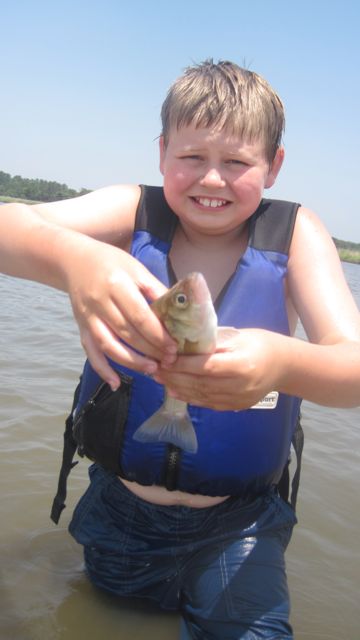Over the past 6 years, while introducing young people to the Chesapeake Bay, I’ve spent some time paddling, fishing, and exploring just about every major tributary. Have I seen it all? Not even close. One of the unique features of the Chesapeake Bay is what Echo Hill Outdoor School’s Capt. Jim Stone, calls the “Thomas’ English Muffin shoreline,” due to all its nooks and crannies. If you were to attempt to walk the shoreline from end to end, you would travel 8,000-11,000 miles. In other words, there’s always something new to see. And no matter how much you’ve seen, the Bay can always surprise you.
Last week I was reminded of both those points when I took a group of 7 boys to Tyaskin, MD for an afternoon of fishing. The boys and I were on a weeklong kayak/camping trip as part of Sultana Projects’ Chesapeake Adventures. Usually these trips are coed, but this one just happened to consist of all boys, ages 11-14. We’d gone fishing earlier in the week, caught a few keepers, and fried them up as an appetizer for dinner. With the memory of fresh fish still in their stomachs, these boys were hungry for more; literally.
Sultana Projects’ Vice President, Chris Cerino, accompanied us for the day and acted as our tour guide. He’d discovered this spot off the Nanticoke River after reading about it in Edward Gertler’s Maryland and Delaware Canoe Trails. Chris had paddled it once, but never fished here, so we were taking a shot in the dark.
After paddling out to look at the remains of a shipwreck, we made our way to the mouth of Wetipquin Creek and stopped at a sandy peninsula that looked promising.
 The first pull of our seine net produced hundreds of small bait-fish (mostly mummichogs) as well as a 6-inch white perch. As the boys baited their hooks, Chris explained to them that fish like to hang out in the current’s eddy. A good technique for finding fish is determining which way the current is running, and dropping your hook in the eddy.
The first pull of our seine net produced hundreds of small bait-fish (mostly mummichogs) as well as a 6-inch white perch. As the boys baited their hooks, Chris explained to them that fish like to hang out in the current’s eddy. A good technique for finding fish is determining which way the current is running, and dropping your hook in the eddy.
Within 5 minutes, 7 hooks were in the water and the boys struggled to find that thing which often eludes young people: patience. As 10 minutes passed with only a few bites and no fish caught, some boys abandoned their rods in favor of swimming.
Meanwhile, Chris took a rod and waded across the channel towards a small island of marsh grass. After a few minutes at his much quieter fishing hole, he reeled in the first fish of the day.
His proclaim of, “FISH ON!” convinced the swimmers to return to their rods. A few boys made their way for Chris’s island, certain that spot was where the fish were hiding.
“FISH ON!” One of the boys next to me reeled in a nice 7-inch white perch. The group swarmed his location.
Over the next hour or so, I don’t think more than 5 minutes passed without someone catching a fish. There is no size limit for the ubiquitous white perch, but my rule of thumb is 6 inches. These were all fat fish between 6 and 12 inches. The words “FISH ON!” echoed around the creek with every tug on a line. It seemed like the more noise the boys made, the more the fish would bite.
It was one of the greatest fishing trips I’ve ever been a part of. We caught at least 40 fish and kept 22; in a water-logged kayak that served as our live well.
The boys learned to scale and gut their fish as I prepared a secret batter taught to me by Echo Hill’s Capt. Andy McCown. As we sat around the campfire and ate fried fish until our bellies were ready to burst, it was hard not to be in awe.
 I hope that when these boys think back on their earliest memories of the Bay, they won’t dwell on the problems of overpopulation, nutrient runoff, or algae blooms. Instead I want them to remember what it feels like to be surprised by the tug on your line as you scream loud enough for all your friends to hear, “FISH ON!”
I hope that when these boys think back on their earliest memories of the Bay, they won’t dwell on the problems of overpopulation, nutrient runoff, or algae blooms. Instead I want them to remember what it feels like to be surprised by the tug on your line as you scream loud enough for all your friends to hear, “FISH ON!”














